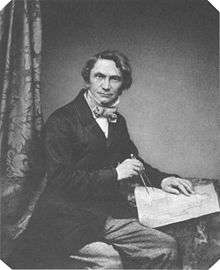August von Voit
Richard Jakob August von Voit (17 February 1801 in Wassertrüdingen – 12 December 1870 in Munich) was a German architect specializing in glass and iron structures.[1]

Notable projects
Voit designed the city hall of Annweiler am Trifels (Rhineland-Palatinate) and the Fruchthalle (Kaiserslautern) in Rhineland-Palatinate. He also designed two synagogues, one in Kirchheimbolanden in 1834, and another in Speyer in 1837.[2] Von Voit also created the neo-Romanesque facade on St. Anna's, Lehel, which was destroyed during the war.[3]
1846-1853 - Neue Pinakothek
The Neue Pinakothek Art Museum was commissioned by Ludwig I of Bavaria and designed by Von Voit and Friedrich von Gärtner. The design of the structure was calculated to reinforce the similarity between the older and newer museums. As part of the design, Von Voit commissioned Wilhelm von Kaulbach to show the achievements of German art in mural form.[4]
The building as originally designed was demolished in 1950 and rebuilt in 1967.[3]
1853-1854 - Glaspalast, Munich
August von Voit, as the Royal Superintendent of Works, assisted in organizing the construction of the Glass Palace at Munich as well as being the architect. In order to ensure the project was completed on schedule, von Voit negotiated a contract with the manufacturers which had an increasing penalty rate for the late supply of goods. The design "used rectangular girders as the elements of the space frame". The Glaspalast was modeled after the London Crystal Palace.[1]
1860-1865 - Great Palm House, Old Botanical Gardens, Munich
This project was built in the form of a "cast-iron space frame with dome".[1]
1867-1869 - Second Large Winter Garden
The Second Large Winter Garden was commissioned by Ludwig II of Bavaria. Von Voit collaborated on the project with Carl von Effner to create a "glass-roofed, three-story structure" which faced both the palace gardens and the Kaiserhof.[1]
Criticisms
The glass and iron style was criticized for its "lack of substance and corporeality", and the iron used in the construction of buildings such as the Glaspalast "proved too brittle and too prone to fire".[5]
Gallery
 Hambacher Schloss
Hambacher Schloss Neue Pinakothek
Neue Pinakothek
References
- Kohlmaier, Georg (1991). Houses of Glass: A Nineteenth-Century Building Type. MIT Press. ISBN 9780262610704.
- Reade, Cyril (2007). Mendelssohn to Mendelsohn: Visual Case Studies of Jewish Life in Berlin. Peter Lang. p. 143. ISBN 9783039105311.
- Rosenfeld, Gavriel David (2000). Munich and Memory: Architecture, Monuments, and the Legacy of the Third Reich. University of California Press. ISBN 9780520923027.
- Sheehan, James J. (2000). Museums in the German Art World : From the End of the Old Regime to the Rise of Modernism: From the End of the Old Regime to the Rise of Modernism. Oxford University Press. pp. 96. ISBN 9780195350524.
August von Voit.
- Kolinsky, Eva (1998). The Cambridge Companion to Modern German Culture. Cambridge University Press. p. 283. ISBN 9780521568708.
External link
![]()